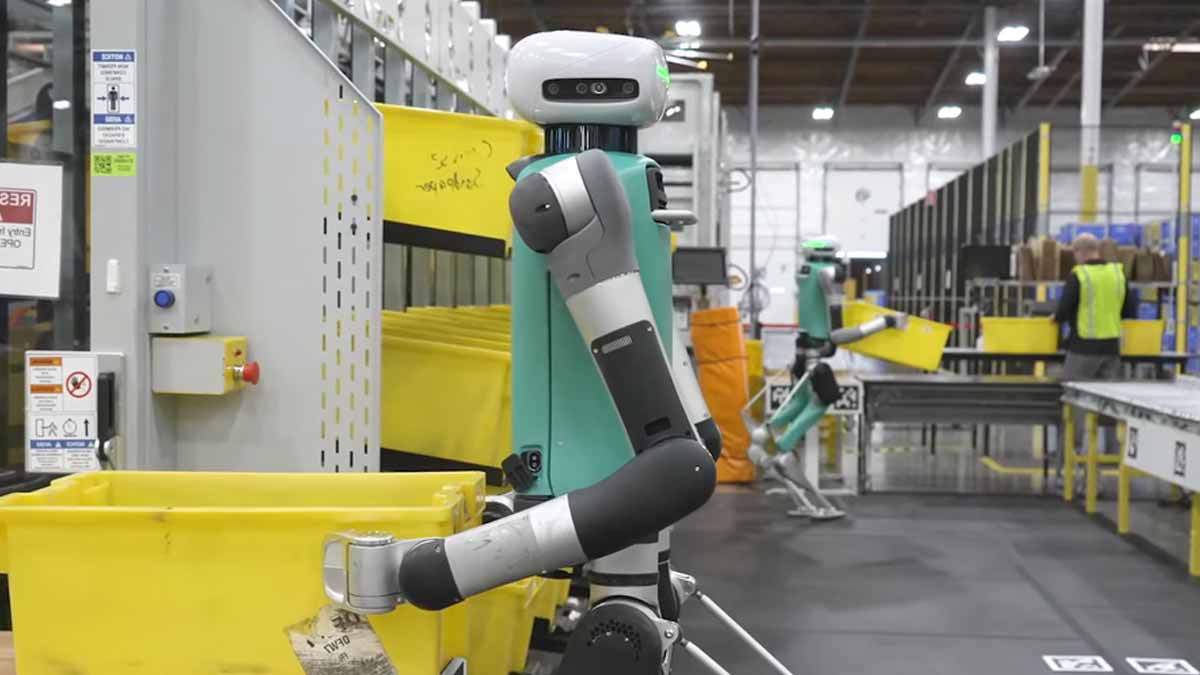Machines now set the pace on the warehouse floor, and Amazon is pushing it faster. The group frames this shift as progress, yet the stakes feel human. Robots multiply, training races, and layoffs linger. The latest rollout in the UK signals a bolder phase. Productivity soars, rights debates harden, and routine tasks vanish. Behind the numbers sits a simple question: who benefits as full automation accelerates? For workers, stability wobbles while expectations rise and timelines keep shrinking.
What Amazon calls a turning point for warehouse work
The company marks a turning point, where robots will soon outnumber people on shifts. New fleets reach British sites, signaling a march to full automation. Warehouse roles change: repetitive movements move to machines, while oversight grows. What once looked like a job engine now looks like a test of work.
Since 2020, the network added one million machines, from robotic arms to wheeled transporters. The fleet expanded fivefold and now almost matches headcount across distribution centers. Automation no longer sits at the margins; it operates at scale. The result: tasks once manual become orchestrated by software, sensors, and mobile platforms.
The company once centered narratives on hiring. Now, the story shifts to throughput, uptime, and seamless flows. This pivot raises unease on the floor. People see lines moving faster, new rules, and fewer stops. As the model scales, clarity on protections, training, and mobility becomes essential to trust now, everywhere.
New UK robots, and how Amazon says the system will work
At British sites, mobile units ferry shelves, robotic arms sort, and vision systems verify picks. Amazon says this reduces strain and moves people to oversight, maintenance, and exceptions. AI routes tasks in real time so stations flow with fewer pauses. The line keeps moving when modules stall, thanks to rerouting.
Output tells the story. Each worker shipped more than 3,870 packages last year, versus 175 in 2015. That leap aligns with wider deployment of grippers, conveyors, and directed picking. Software sequences tasks to cut idle time, so one person now triggers flows once handled by teams, then tracks exceptions.
The chief executive frames the goal simply: leave repetitive tasks to machines so jobs get more interesting. He also accepts the tradeoff: fewer people will do roles that become automated. That candor clarifies the choice now facing logistics workforces. The promise rests on training and mobility arriving before positions disappear.
Visible effects on jobs, safety, pace, and daily routines
On the floor, benefits and risks show up together. Machines lift, carry, and turn, which reduces strain from awkward reaches and heavy loads. People face pace pressure from timers and targets. Good rules on rest, temperature, and footwear help. Design choices, not only technology, determine how safe the shift feels.
Amazon can curb micro-stoppages with smarter sequencing, yet people still handle exceptions. When conveyors jam or a barcode misreads, judgment matters. Clear escalation paths keep small problems small. Shared dashboards reduce confusion about targets. When teams see why metrics shift, they adjust and frustration fades the loop feels fair.
Actionable basics help. Train on incident drills before peak season. Pair new hires with mentors for the first month. Tune scanners and lighting to cut read errors. Publish weekly safety wins and misses. Calibrate pace calculators with real recovery time, so performance targets guide work without turning risk into routine.
Numbers, timelines, and how automation outruns retraining
According to company figures, 700,000 employees have been trained since 2019. Yet 27,000 roles have been cut since 2022, including in retail and devices. Automation appears to move faster than retraining. Many eliminated positions are not replaced but reconfigured as machine-supervised flows, leaving fewer ladders for advancement.
Executives say AI shortens delivery paths and improves the experience for workers and customers. People on the floor hear it and wonder which workers benefit. Fear concentrates in routine roles most exposed to substitution. Trust needs specifics: timelines for upskilling, funded slots, and guarantees that mobility will not disappear midstream.
Fleet growth tracks an inflection. Robots multiplied fivefold since 2020 and now approach parity with headcount. If deployments continue, outnumbering looks imminent at large sites. That milestone is symbolic and operational. Staffing models, shift planning, and safety reviews must assume software schedules work, while people handle edge cases and recovery.
Paths to an inclusive future that keeps people in the loop
An inclusive plan starts where anxiety lives. Tie training seats to openings, with paid time and certifications that travel. Guarantee wage insurance during redeployment. Publish transfer wait times, not only success stories. Give teams say over pilot tests, so feedback shapes designs before rollouts, and safety rules arrive with tools.
Signal matters as much as speed. Amazon can prove intent by funding career transitions with tracked outcomes. List the jobs that grow because of automation, not just those that shrink. Show how pay evolves when tasks move to oversight, maintenance, or testing. People trust plans they can see and verify.
Public policy will shape the edges. Wage insurance, benefits, and credits for upskilling can smooth shocks. Partnerships with colleges and apprenticeships build pipelines. Transparent safety reporting sets a floor. When governments, employers, and workers co-design transitions, people see a path, not a cliff. Adoption continues without breaking communities too.
What matters next as automation reshapes everyday work
Full automation now feels less like a headline and more like a plan in motion. The UK rollout shows pace, but the lasting test is trust. Amazon can anchor confidence by pairing deployments with visible mobility, funded training, and honest reporting. Workers read signals, not slogans. Protect dignity, keep opportunity real, and measure outcomes, not intentions. If that contract holds, the warehouse of the future might feel fair as well as fast.
